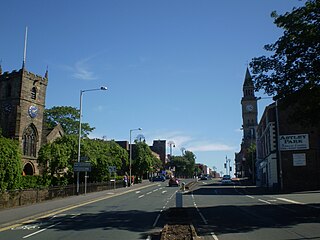
Chorley is a town and the administrative centre of the wider Borough of Chorley in Lancashire, England, 8 miles (13 km) north of Wigan, 11 miles (18 km) south west of Blackburn, 11 miles (18 km) north west of Bolton, 12 miles (19 km) south of Preston and 20 miles (32 km) north west of Manchester. The town's wealth came principally from the cotton industry.

The Borough of Chorley is a local government district with borough status in Lancashire, England. It covers the towns Adlington and Chorley. The borough also extends to several villages and hamlets including Buckshaw Village, Croston, Eccleston, Euxton and Whittle-le-Woods.

Coppull is a village and civil parish in Lancashire, England. It is part of the Borough of Chorley, lies around 300 feet (91 m) above sea level. Its population is around 8,000, having been counted at 7,959 in the 2011 Census. It is bounded by Whittle Brook, Clancutt Brook, the River Yarrow, Eller Brook, Hic-Bibi Brook and Stars Brook. Coppull is located between Chorley and Standish, Greater Manchester, to the east of the A49 road near Charnock Richard.

Eccleston is a village and civil parish of the Borough of Chorley in Lancashire, England. It is beside the River Yarrow, and was formerly an agricultural and later a weaving settlement.

Rivington Pike is a hill on Winter Hill, part of the West Pennine Moors at Rivington, Chorley in Lancashire, England. The nearest towns are Adlington and Horwich. The land and building are owned and managed by Chorley Council. The Pike Tower is a prominent local landmark and is located at the summit, it is part of Lever Park. The area is popular with hill walkers and for mountain biking.

Bretherton is a small village and civil parish in the Borough of Chorley, Lancashire, England, situated to the south west of Leyland and east of Tarleton. The population of the civil parish at the 2011 census was 669. Its name suggests pre-conquest origins and its early history was closely involved with the manor house Bank Hall and the families who lived there. Bretherton remained a rural community and today is largely residential with residents commuting to nearby towns.
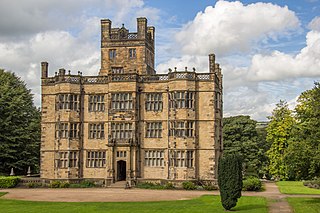
Gawthorpe Hall is an Elizabethan country house on the banks of the River Calder, in Ightenhill, a civil parish in the Borough of Burnley, Lancashire, England. Its estate extends into Padiham, with the Stockbridge Drive entrance situated there. The house is traditionally attributed to Robert Smythson. In the mid-19th century, the hall was rebuilt by Charles Barry, the architect of the Houses of Parliament. Since 1953 it has been designated a Grade I listed building. In 1970 the 4th Lord Shuttleworth gave the hall to the National Trust, with a 99-year lease to Lancashire County Council. Both bodies jointly administer the hall and in 2015 the council provided £500,000 funding for restoration work on the south and west sides of the house.
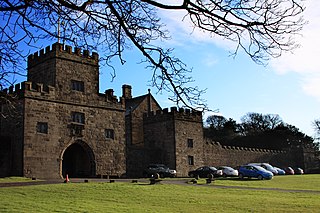
Hoghton Tower is a fortified manor house two-thirds of a mile (1 km) east of the village of Hoghton, Lancashire, England, and standing on a hilltop site on the highest point in the area. It takes its name from the de Hoghton family, its historical owners since at least the 12th century. The present house dates from about 1560–65.
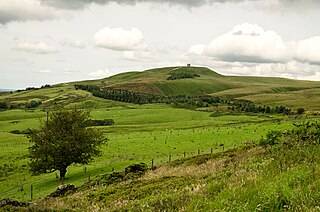
Rivington is a village and civil parish of the Borough of Chorley, Lancashire, England, occupying 2,538 acres. It is about 6 miles (9.7 km) southeast of Chorley and about 8+1⁄2 miles (13.7 km) northwest of Bolton. Rivington is a rural area consisting primarily of agricultural grazing land, moorland, with hill summits including Rivington Pike and Winter Hill within the West Pennine Moors. The area has a thriving tourist industry centred around reservoirs created to serve Liverpool in the Victorian era and Lever Park created as a public park by William Lever at the turn of the 20th century, with two converted barns, a replica of Liverpool Castle and open countryside. Rivington and Blackrod High School is located here. Rivington and its village had a population of 109 at the 2011 Census.

Hoghton is a small village and civil parish in the Borough of Chorley, Lancashire, England. At the 2011 Census, it had a population of 802. Brindle and Hoghton ward also includes the parish of Brindle.

Gregson Lane is a village in Lancashire, England. It is situated between Bamber Bridge, Higher Walton, Coupe Green and Brindle, and is within four miles of the city of Preston.
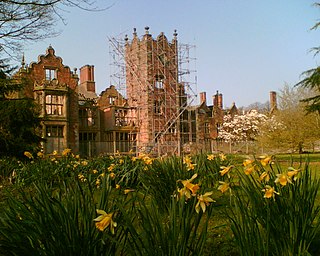
Bank Hall is a Jacobean mansion in Bretherton, Lancashire, England. It is a Grade II* listed building and is at the centre of a private estate, surrounded by parkland. The hall was built on the site of an older house in 1608 by the Banastres who were lords of the manor. The hall was extended during the 18th and 19th centuries. Extensions were built for George Anthony Legh Keck in 1832–1833, to the design of the architect George Webster.
This is a list of Grade I listed buildings in Lancashire, England.

Rivington in the Borough of Chorley, Lancashire, is situated on the edge of the West Pennine Moors, at the foot of Rivington Pike overlooking reservoirs created for Liverpool Corporation Waterworks in the 19th century. There are twenty eight listed buildings within Rivington, two are classified by English Heritage as Grade II*, the rest as Grade II; Rivington has no Grade I Listed buildings.
The Bank Hall Estate is the demesne of the Jacobean mansion house of Bank Hall, including much of land around the village of Bretherton, which is owned by the Lilford Trust.

Browsholme Hall is a privately owned Tudor house in the parish of Bowland Forest Low in the borough of Ribble Valley, Lancashire, England. It is claimed to be the oldest surviving family home in Lancashire. Since 1954, it has been designated a Grade I listed building by English Heritage.

Holy Trinity Church is in the village of Hoghton, Lancashire, England. It is an active Anglican parish church in the deanery of Leyland, the archdeaconry of Blackburn, and the diocese of Blackburn. The church is recorded in the National Heritage List for England as a designated Grade II listed building. It is a Commissioners' church, having received a grant towards its construction from the Church Building Commission.

St George's Church is in St George's Street, Chorley, Lancashire, England. It is an active Anglican parish church in the deanery of Chorley, the archdeaconry of Blackburn, and the diocese of Blackburn. The church is recorded in the National Heritage List for England as a designated Grade II* listed building. It was a Commissioners' church, having received a grant towards its construction from the Church Building Commission.
Hoghton is a civil parish in the Borough of Chorley, Lancashire, England. It contains 16 buildings that are recorded in the National Heritage List for England as designated listed buildings. Of these, two are listed at Grade I, the highest of the three grades, and the others are at Grade II, the lowest grade. The major building in the parish is Hoghton Tower; this and associated structures are listed. Otherwise the parish in mainly rural, and a number of farmhouses and farm buildings are listed. The other listed buildings consist of two churches, a former school, a war memorial, and a railway viaduct.

Terraced Gardens of Rivington is a landscaped woodland on the hillside of Rivington Pike, in Rivington Parish in the Chorley Borough of Lancashire, England, originally designed as a Garden by T.H. Mawson and built as curtilage to a home of the soap magnate Viscount Leverhulme; as such, the area is not part of Lever Park. The gardens contains and abuts the SSSI of the West Pennine Moors. Today the former gardens are Grade II listed and contain eleven Grade II structures. The original design had three elements — the upper part being in the romanesque architectural style, the lower section, known as the Ravine, was a woodland with a man-made stream, and a Japanese-style garden, with a man-made pond constructed of Pulmonite which remains today. The gardens are leased to Rivington Heritage Trust by United Utilities and are undergoing restoration and preservation.



















